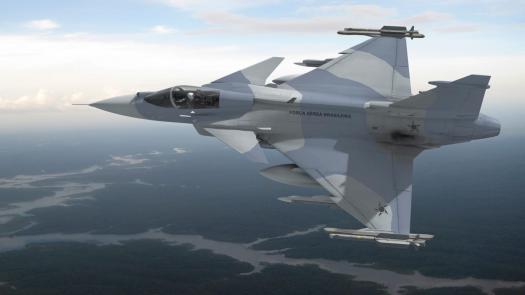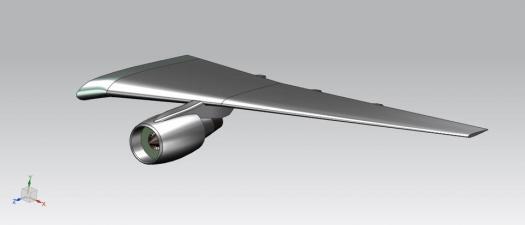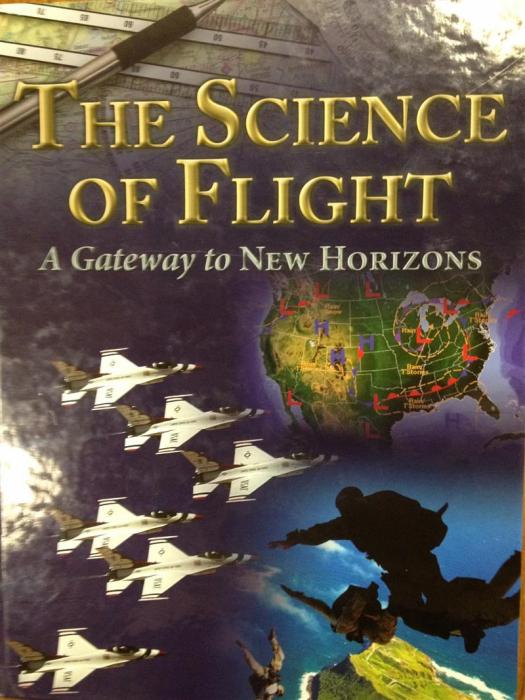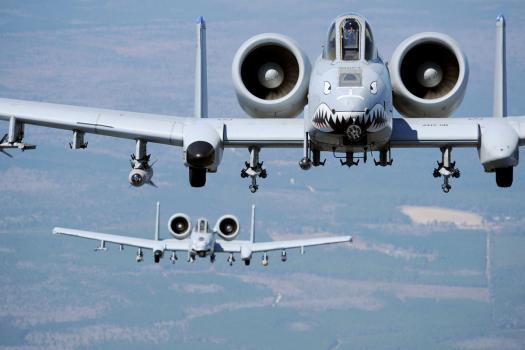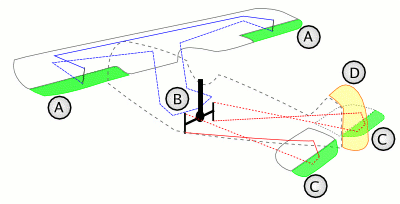Flight Control Surface & Force

. Flight control surface
- 1.
Explain the relationship between the movement of the ailerons and the resulting forces that cause an aircraft to roll.
- 2.
The elevator is typically located on the:
- A.
Left Canard
- B.
Right Canard
- C.
Horizontal Stabilizer
- D.
Vertical Stabilizer
- E.
Trim Tab
Correct Answer
C. Horizontal StabilizerExplanation
The correct answer is Horizontal Stabilizer. The elevator, which is the movable part of the horizontal stabilizer, is typically located on the horizontal stabilizer. The horizontal stabilizer is a fixed wing-like structure located at the tail of an aircraft, designed to provide stability and control during flight. The elevator controls the pitch of the aircraft, allowing it to climb or descend.Rate this question:
-
- 3.
These two forces need to overcome their opposite force in order for an aircraft to fly
- A.
Drag and Wing Shape
- B.
Propellers & Ruddervators
- C.
Flaps and Slats
- D.
Lift and Turbulence
- E.
Lift and Thrust
Correct Answer
E. Lift and ThrustExplanation
In order for an aircraft to fly, two forces need to overcome their opposite force. Lift is the upward force that counteracts the weight of the aircraft and allows it to stay in the air. Thrust is the forward force that propels the aircraft through the air. These two forces work together to overcome the opposing forces of drag and gravity, allowing the aircraft to achieve flight.Rate this question:
-
- 4.
The name of the force that tries to push an aircraft up
Correct Answer
LiftExplanation
Lift is the upward force that is generated on an aircraft's wings as a result of the air flowing over them. When air flows over the wings, it creates a pressure difference between the upper and lower surfaces of the wing. This pressure difference results in an upward force called lift, which opposes the force of gravity and allows the aircraft to stay in the air and climb. Therefore, lift is the force that tries to push an aircraft up.Rate this question:
- 5.
This is the name of the force that tries to hold an aircraft back.
Correct Answer
DragExplanation
Drag is the force that acts opposite to the motion of an aircraft and tries to hold it back. It is caused by the resistance of the air as the aircraft moves through it. Drag is an important force to consider in aviation as it affects the performance and efficiency of an aircraft. By understanding and managing drag, pilots and engineers can optimize the design and operation of aircraft to improve performance and fuel efficiency.Rate this question:
- 6.
This is the name of the force that tries to pull an aircraft down.
Correct Answer
Weight
GravityExplanation
Weight and gravity are both forces that act on an aircraft, but weight specifically refers to the force with which the aircraft is pulled down towards the earth. Gravity is the fundamental force that causes weight and is responsible for the attraction between objects with mass. Therefore, weight is the correct answer as it directly relates to the force that tries to pull an aircraft down.Rate this question:
- 7.
The aircraft rudder is located on the
- A.
Horizontal Stabilizer
- B.
Stabilator
- C.
Vertical Stabilizer
- D.
Fuselage
- E.
Flaperon
Correct Answer
C. Vertical StabilizerExplanation
The correct answer is Vertical Stabilizer. The vertical stabilizer is a part of the aircraft's tail section and is located vertically at the rear of the fuselage. It provides stability and control during flight by controlling the yaw motion of the aircraft. The rudder, which is a movable control surface, is attached to the vertical stabilizer and is used to control the aircraft's yawing motion.Rate this question:
-
- 8.
The ailerons control yaw
- A.
True
- B.
False
Correct Answer
B. FalseExplanation
The statement is incorrect. Ailerons are control surfaces on the wings of an aircraft that control roll, not yaw. Yaw is controlled by the rudder, which is typically located on the tail of the aircraft. Therefore, the correct answer is false.Rate this question:
-
- 9.
Pitch is controlled by what flight control surface
Correct Answer
Elevator
ElevatorsExplanation
The correct answer is Elevator/Elevators. The pitch of an aircraft is controlled by the elevator or elevators. The elevator is a control surface located at the tail of the aircraft that is responsible for controlling the pitch, which is the up and down motion of the aircraft's nose. By moving the elevator up or down, the pilot can adjust the pitch and control the aircraft's altitude. Elevators are typically found on the horizontal stabilizer of the aircraft and work in pairs, with one on each side.Rate this question:
- 10.
If the pilot moves the stick or yoke to the left for a left turn, what does the left aileron do
- A.
It goes up
- B.
It goes up initially then sharply down
- C.
It goes down
- D.
It goes down initially then sharply up
Correct Answer
A. It goes upExplanation
When the pilot moves the stick or yoke to the left for a left turn, the left aileron goes up. This upward movement of the left aileron decreases the lift on the left wing, causing it to drop slightly. This differential lift between the two wings helps the aircraft to roll to the left and initiate the turn.Rate this question:
-
- 11.
When the pilot moves the stick or yoke for a turn the ailerons move
- A.
In the same direction
- B.
In opposite directions
- C.
It depends on the way the aircraft is being turned
- D.
The ailerons do not move during a turn
Correct Answer
B. In opposite directionsExplanation
When the pilot moves the stick or yoke for a turn, the ailerons move in opposite directions. This is because the ailerons are control surfaces located on the wings of an aircraft, and their movement is responsible for rolling the aircraft. When the pilot moves the stick or yoke to the left, the left aileron moves up while the right aileron moves down. This differential movement creates a difference in lift between the wings, causing the aircraft to roll and initiate a turn. Similarly, when the pilot moves the stick or yoke to the right, the ailerons move in opposite directions, maintaining the desired control and stability during the turn.Rate this question:
-
- 12.
Flaps increase
- A.
Speed
- B.
Drag
- C.
Thrust
- D.
Airspeed
- E.
Annually
Correct Answer
B. DragExplanation
Flaps increase drag. Flaps are aerodynamic surfaces on the wings of an aircraft that can be extended or retracted. When flaps are extended, they increase the surface area of the wings, resulting in increased drag. This increased drag helps to slow down the aircraft during landing or takeoff, allowing for a safer and more controlled approach. By increasing drag, flaps also help to decrease the aircraft's speed, which is beneficial in certain flight conditions.Rate this question:
-
- 13.
The pilot flying this aircraft has her/his foot pushing down on which rudder to make the nose go in which direction (from the pilots point of view)
- A.
Left / Left
- B.
Left / Right
- C.
Right / Right
- D.
Right / Right
- E.
Not enough information, the rudder is not visible
Correct Answer
A. Left / LeftExplanation
The pilot flying this aircraft has her/his foot pushing down on the left rudder to make the nose go to the left. This is because the rudder controls the yawing motion of the aircraft, which is the left or right movement of the nose. By pushing down on the left rudder, the pilot can create a force that directs the nose to the left.Rate this question:
-
- 14.
What are the names of the aircraft parts in this order: B, C, E
- A.
Vertical Stabilizer, Horizontal Stabilizer, Flaperons
- B.
Aileron, Rudder, Speed Brakes
- C.
Rudder, Lower Rudder, Wing Tip Vortices
- D.
Rudder, Elevator, Ailerons
- E.
Rudder, Elevator, Stick Controls
Correct Answer
D. Rudder, Elevator, AileronsExplanation
The correct answer is Rudder, Elevator, Ailerons. The rudder is a vertical stabilizer that controls the yawing motion of the aircraft. The elevator is a horizontal stabilizer that controls the pitching motion of the aircraft. The ailerons are control surfaces on the wings that control the rolling motion of the aircraft. These three parts work together to control the movement and stability of the aircraft during flight.Rate this question:
-
- 15.
The main lifting devices on an aircraft are the
Correct Answer
Wing
WingsExplanation
The correct answer is "Wing, Wings". The main lifting devices on an aircraft are the wings. The wings generate lift by creating a pressure difference between the upper and lower surfaces, allowing the aircraft to stay airborne. The term "wings" is used in the plural form because an aircraft typically has two wings, one on each side of the fuselage.Rate this question:
- 16.
The main source of thrust on large commercial airliners is/are
Correct Answer
Engine
Engines
Jet EnginesExplanation
The correct answer is engines, specifically jet engines. Large commercial airliners are typically powered by multiple jet engines, which generate thrust by expelling high-speed exhaust gases. These engines are designed to provide the necessary power and propulsion for the aircraft to take off, maintain altitude, and reach its destination.Rate this question:
- 17.
What percentage of your overall grade comes from your Science of Flight grades
- A.
40%
- B.
20%
- C.
100%
- D.
80%
- E.
Aeries.com randomly selects a percentage
Correct Answer
A. 40%Explanation
The correct answer is 40% because it is stated in the question that "What percentage of your overall grade comes from your Science of Flight grades" and the option 40% is the only one that directly answers this question.Rate this question:
-
- 18.
You are on takeoff roll in your F-16 jet fighter. At the correct speed you ease back on the stick and begin to climb. When you pulled back on the stick your elevators moved
- A.
Left and Right to maintain symmetry
- B.
Down
- C.
Up
- D.
Left or Right depending on the crosswind
- E.
The elevators are not connected to the stick, but to the pilots pedals on the floor
Correct Answer
C. UpExplanation
When the pilot pulls back on the stick in an F-16 jet fighter during takeoff, the elevators move up. This upward movement of the elevators helps to increase the angle of attack of the aircraft, which generates lift and allows the aircraft to climb. The upward movement of the elevators is essential for the aircraft to transition from the horizontal takeoff roll to a climbing trajectory.Rate this question:
-
- 19.
You are flying in your two engine A-10 Warthog Attack aircraft and three huge geese fly into your left engine (#1 engine ) the nose of your planes rapidly moves to the ________ so you step on the ________ rudder to bring the nose of the aircraft back to your flightpath.
- A.
Right / Right
- B.
Left / Right
- C.
Left / Left
- D.
Right / Left
- E.
Two engine aircraft do not need rudders
Correct Answer
B. Left / RightExplanation
When the geese fly into the left engine of the aircraft, it causes an imbalance in thrust, resulting in the nose of the plane rapidly moving to the left. To bring the nose of the aircraft back to the flightpath, the pilot needs to step on the right rudder. Stepping on the right rudder creates a yawing motion, which counteracts the left movement of the nose and helps the pilot regain control and bring the aircraft back on track.Rate this question:
-
- 20.
This plane is flying straight and level. If the "C" flight controls go down and the left "A" goes up and the right "A" goes down the aircraft will
- A.
climb and remain flying straight
- B.
Descend and turn right
- C.
Descend and turn left
- D.
Climb and turn left
- E.
Climb and turn right
- F.
Yaw sharply up and pitch right
Correct Answer
C. Descend and turn leftExplanation
If the left "A" flight control goes up and the right "A" goes down, it means that the left aileron is raised and the right aileron is lowered. This configuration creates a higher lift on the left wing and a lower lift on the right wing, causing the aircraft to roll to the left. As a result, the aircraft will descend and turn left.Rate this question:
-
- 21.
Pitch is controlled by both ailerons
- A.
True
- B.
False
Correct Answer
B. FalseExplanation
Pitch is controlled by the elevator, not the ailerons. The ailerons are responsible for controlling the roll of an aircraft, while the elevator controls the pitch. The elevator is typically located on the tail of the aircraft and is used to change the angle of the aircraft's nose up or down, resulting in a change in pitch. Therefore, the statement that pitch is controlled by both ailerons is incorrect.Rate this question:
-
- 22.
Which of the following fly?
- A.
Ducks
- B.
F-35 Fighters
- C.
B-2 Bombers
- D.
Boeing 777 Airliners
- E.
Icon A-5 Flying Boats, made in Vacaville, CA
- F.
Geese
- G.
Ostriches
Correct Answer(s)
A. Ducks
B. F-35 Fighters
C. B-2 Bombers
D. Boeing 777 Airliners
E. Icon A-5 Flying Boats, made in Vacaville, CA
F. GeeseExplanation
All of the options listed in the answer can fly. Ducks, geese, and ostriches are birds that are capable of flight. F-35 Fighters, B-2 Bombers, Boeing 777 Airliners, and Icon A-5 Flying Boats are all aircraft that are designed for flying.Rate this question:
-
Quiz Review Timeline +
Our quizzes are rigorously reviewed, monitored and continuously updated by our expert board to maintain accuracy, relevance, and timeliness.
-
Current Version
-
Jan 20, 2025Quiz Edited by
ProProfs Editorial Team -
Feb 14, 2018Quiz Created by
DavidAv







